PSI Genesis “Big-Air” Carb – First Look
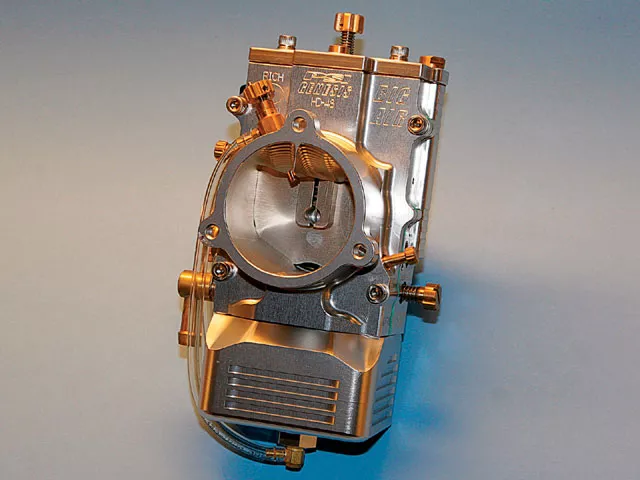

(1.) The entry side of the Genesis carb shows the V-shaped throat at the bottom, vortexes at 12 and 6 o’clock, ribbed walls, and a closed flat slide. Also seen is the powerjet protruding into the venturi at 11- o’clock and the needle’s adjuster on top of the carb.

(2.) On the right side of the Genesis carb, you’ll find the pilot fuel (right) and pilot air (left) adjusting screws.
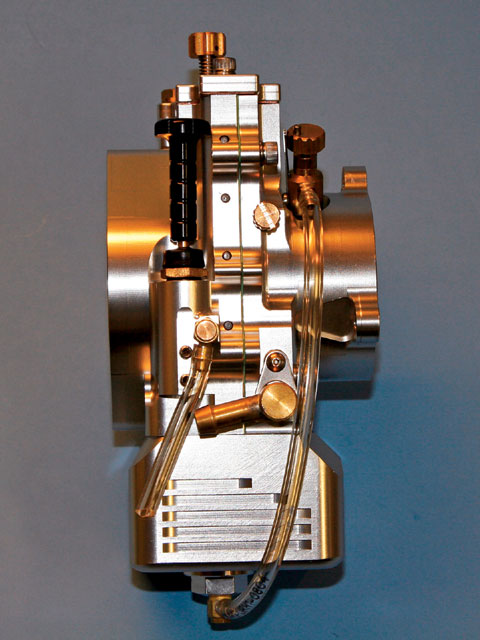
(3.) The left side of the carb includes the idle speed adjusting screw (middle right), black enrichener knob (middle left), rotating fuel inlet fitting (bottom right), and fuel bowl vent (bottom left). The clear fuel line from the bottom of the float bowl leads to the adjustable powerjet (main) mounted in the venturi.
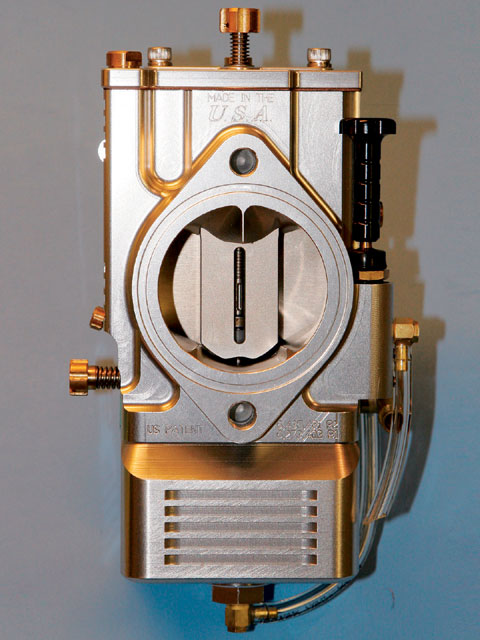
(4.) The backside (manifold side) of the carb’s throat shows two small vortexes on the floor and one large vortex on top leading from the flat slide along with heavy ribbing at the top.

(5.) The float bowl is disassembled by removing the powerjet’s fuel line and the 17mm bowl nut. Most fittings are sealed with O-rings. Shown is an early Series 3 carb. The newer Series 4 version has a 50-percent larger fuel bowl.

(6.) The slide, spring, and needle are removed by unscrewing two 5/32-inch Allen screws from the carb’s top cover. The needle’s 25-clicker adjuster is seen at the top of the cover with the throttle cable’s mounting ferrule on the right.
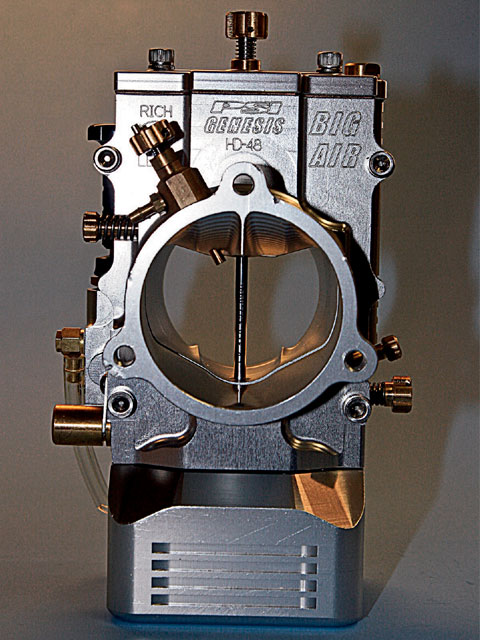
(7.) Opening the throttle raises the slide, exposing the needle. Here’s a front view of the carb’s venturi with the slide open. The venturi’s V-shaped bottom, single vortex at top and bottom, and ribbing are clearly evident.
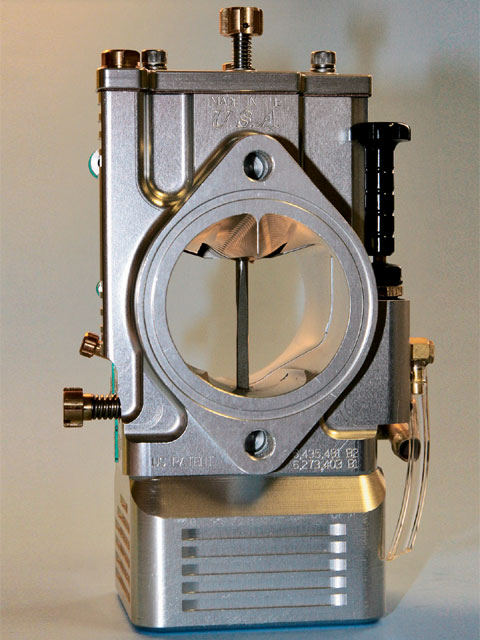
(8.) Shown is a backside (manifold side) view of the carb’s venturi with the slide open. Notice the twin vortexes on the throat’s bottom.

(9.) After removing the float bowl and top cover, the two-part carb body is disassembled by removing four Allen screws. The slide’s eight roller bearings (left side) are clearly visible as is the V-shape of the venturi.
PSI specializes in the design, testing, and manufacturing of innovative high-performance products for the snowmobile, motorcross, ATV, and Harley-Davidson V-Twin marketplace. PSI began in a three-car Wisconsin garage in 1983, building 2-stroke exhausts systems for the MX and snowmobile industries. By ’85, PSI moved into a 30,000 square-foot building with a SuperFlow dyno and grew to over 40 employees. In the ’90s, PSI became involved in Personal Watercraft racing and was picked by Seadoo to campaign one of its national race teams. During that time, PSI also developed Genesis snowmobile engines that produced 200-300 horsepower reliably and could be trail ridden or raced. Today, PSI snowmobile engines produce between 350-500 horsepower.
About eight years ago, PSI received two patents for unique carb designs for its snowmobile engines and received “best engineering” awards for them. As it turned out, some of PSI’s snowmobile customers, who also ride Harleys, recommended that PSI adapt its unique carb technology to the V-Twin engine. Over the past two years, PSI developed its idea of the perfect fuel mixer for the V-Twin industry: the Genesis “Big-Air” carb.
Design objectives for the Genesis Big-Air carb included high airflow, excellent fuel vaporization and throttle response, the ability to throttle smoothly without an accelerator pump, simple tuning with easy external adjustments, and the ability to meet 2010 emissions standards. Of course, the new carb required rockin’ good looks and had to be American-made out of the highest quality components. Straight out of the box, PSI’s Patented Genesis Big-Air carb screams, “I am different.” And different it is. According to Bruce Kahlhamer, President of PSI, the Genesis Big-Air carb satisfies a wide range of engine displacements because of its unique design.
The 48mm PSI carb is machined from high-quality billet aluminum and has a variable venturi controlled by a hard-anodized flat throttle slide supported by eight roller bearings (four per side) for smooth operation. The benefit of a variable-venturi versus a fixed-venturi is that because the size of the venturi varies based on throttle position, air moves through the carb faster at part throttle for improved fuel atomization and throttle response at low-rpm operation. However, that said, the flat slide is about all the Genesis carb has in common with other flat-slide carbs. The rest of the Genesis carb’s throat area is a major departure from anything else on the market today. One glance into the carb’s venturi will quickly show you why.
Unique Design
For starters, the throat of the Genesis carb is not the traditional spherical shape; instead, the bottom third is V-shaped with slightly radiused walls. The throat is five-axis CNC-machined with slight ribbing covering the entire 360-degree interior circumference. The ribs are designed to keep fuel in suspension while generating a boundary layer that can actually improve airflow.
Another unique feature of the Genesis carb are vortex generators machined into the bottom and top of the carb’s throat. Small vortex generators at the bottom (one on the entry side, two on the exit) increase air velocity at low-throttle settings for improved fuel atomization and throttle response while large vortexes at the top (one each on the entry and exit sides) improve velocity at high-throttle settings. The combination of a V-shaped throat, vortexes, and rib walls provide maximum velocity at low speeds and maximum flow on the top end. The result is a carburetor providing the best of both worlds: Response of a 38mm carb at low throttle settings with flow greater than a 48mm at wide open.
Air/fuel Adjustments
There are no jets to change or accelerator pump to fiddle with when making air/fuel ratio adjustments on the Genesis Big-Air carb-all adjustments are made externally in seconds. The carb includes three simple fuel circuits: pilot fuel (low speed), needle (midrange), and powerjet system (main). It also has a pilot air circuit. Since all circuits are externally adjustable, no disassembly or carb removal is required for tuning. All midrange tuning of the needle, the foremost tuning circuit, is accomplished by turning an external 25-clicker adjustment screw located on top of the carb. The clicker moves the tapered needle up (richer) or down (leaner) the equivalent of 15 jet sizes. Three different slide designs are available based on engine displacement: mild, medium and aggressive. PSI conducted extensive testing of slide and needle combinations, so the combinations are highly developed for great throttle response for various engine combinations. The flat slide design, ribbed walls, and vortex generators produce highly atomized and vaporized fuel, eliminating the need for a conventional accelerator pump to prevent low-speed stumbles. For cold weather starting, a push-pull enrichener is located near the top left of the carb for easy access.
The Genesis Big-Air carb is a direct bolt-on to an S&S; Super G two-bolt intake manifold and utilizes the Super G’s three-bolt pattern on the air cleaner side. It also has the same width front to back (3.515-inch) as the Super G Shorty carb. For throttle control, the carb is available with either a single cable pull for a clean, simple design or optional second cable on the newest model, the Series 4. The new Genesis Series 4 carb includes several enhancements over the earlier Series 3, including a larger float bowl, shorter throttle pull, and enhanced vortex generators, just to name a few. PSI’s carburetors come with a three-year warranty and are available in bright dipped clear anodized billet, bright black anodized or chrome plated finishes. Also included with every carb are installation and tuning instructions along with a setup sheet showing all fuel circuit settings and the exact slide and needle installed at the factory.
Conclusion
PSI may be new to the V-Twin performance industry, but after a first look at the Genesis Big-Air carb, it becomes clear that PSI is bringing some fresh ideas to a matured industry. The Genesis carb is a highly sophisticated design with V-shaped technology, yet simply engineered with three external fuel adjustments and one air adjustment for easy tuning. When those benefits are combined with impressive looks, quality components, and the ability to meet 2010 emissions standards, you have a winning combination. Moreover, PSI says the Genesis Big-Air carb is so simple, even a caveman can use it.






